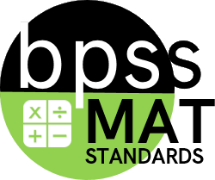BPS District Mathematics Standards Book
K-8 Grade Levels
Grade 05
Fifth Grade Math
"I can ... statements"
 Fifth grade is a milestone and a pivot point for students. The classroom focus on arithmetic during the elementary grades will develop into a more formal study of algebra in middle school. To be ready for algebra, students must have an understanding
of fractional arithmetic, in part because even simple equations cannot be solved without fractions. Because of this, whole-number arithmetic comes mostly to a close in 5th grade, while multiplying and dividing fractions becomes a major focus.
Fifth grade is a milestone and a pivot point for students. The classroom focus on arithmetic during the elementary grades will develop into a more formal study of algebra in middle school. To be ready for algebra, students must have an understanding
of fractional arithmetic, in part because even simple equations cannot be solved without fractions. Because of this, whole-number arithmetic comes mostly to a close in 5th grade, while multiplying and dividing fractions becomes a major focus.
MAT-05.OA Domain:
[OA] Operations and Algebraic Thinking
- MAT-05.OA.01 Use parentheses, brackets, or braces in numerical expressions, and evaluate expressions with these symbols.
- MAT-05.OA.02 Write simple expressions that record calculations with numbers. Interpret numerical expressions without evaluating them.
- MAT-05.OA.03 Generate two numerical patterns using two given rules. Identify apparent relationships between corresponding terms. form ordered pairs consisting of corresponding terms from the two patterns. Graph the ordered pairs on a coordinate plane. Use the Graph to verify relationships.
- MAT-05.OA.04 Find all factor pairs for a whole number in the range 1-100. Recognize that a whole number is a multiple of each of its factors. Determine whether a given whole number in the range 1-100 is a multiple of a given one-digit number. Determine whether a given whole number in the range 1-100 is prime or composite.
MAT-05.NBT Domain:
[NBT] Number and Operations in Base Ten
- MAT-05.NBT.01 Recognize that in a multi-digit number, a digit in one place represents 10 times as much as it represents in the place to its right and 1/10 of what it represents in the place to its left.
- MAT-05.NBT.02 Explain patterns in the number of zeros of the product when multiplying a number by powers of 10. Explain patterns in the placement of the decimal point when a decimal is multiplied or divided by a power of 10. Use whole-number exponents to denote powers of 10.
- MAT-05.NBT.03 Read, Write, and compare decimals to thousandths.
- MAT-05.NBT.03.a Read and write decimals to thousandths using base-ten numerals, word form, and expanded form
- MAT-05.NBT.03.b Compare two decimals to thousandths based on meanings of the digits in each place, using >, =, and < symbols to record the results of comparisons.
- MAT-05.NBT.04 Use place value understanding to round decimals to any place.
- MAT-05.NBT.05 Fluently multiply multi-digit whole numbers using strategies flexibly, including the standard algorithm.
- MAT-05.NBT.06 Using strategies based on place value, the properties of operations, and/or the relationship between multiplication and division, Find whole-number quotients of whole numbers with up to four-digit dividends and two-digit divisors. Illustrate and Explain the calculation by using equations, rectangular arrays, and/or area models.
- MAT-05.NBT.07 Using concrete models or drawings and strategies based on place value, properties of operations, and/or the relationship between addition and subtraction, add, subtract, multiply, and divide decimals to hundredths. Relate the strategy to a written method and Explain the reasoning used.
MAT-05.NF Domain:
[NF] Number and Operations Fractions
- MAT-05.NF.01 Add and subtract fractions with unlike denominators (including mixed numbers) by replacing given fractions with equivalent fractions in such a way as to produce an equivalent sum or difference of fractions with like denominators
- MAT-05.NF.02 Solve word problems involving addition and subtraction of fractions referring to the same whole, including cases of unlike denominators, by using visual fraction models and equations to represent the problem. Use benchmark fractions and number sense of fractions to estimate Mentally and Assess the reasonableness of answers.
- MAT-05.NF.03 Interpret a fraction as division of the numerator by the denominator (a/b = a ≈ b). Solve word problems involving division of whole numbers leading to answers in the form of fractions or mixed numbers by using visual fraction models and equations to represent the problem
- MAT-05.NF.04 Apply and extend previous understandings of multiplication to multiply a fraction or whole number by a fraction.
- MAT-05.NF.04.a Interpret the product (a/b) ╫ q as a parts of a partition of q into b equal parts; equivalently, as the result of a sequence of operations a ╫ q ≈ b.
- MAT-05.NF.04.b. Find the area of a rectangle with fractional side lengths by tiling it with unit squares of the appropriate unit fraction side lengths, and show that the area is the same as would be found by multiplying the side lengths. Multiply fractional side lengths to find areas of rectangles. Represent fraction products as rectangular areas.
- MAT-05.NF.05 Interpret multiplication as scaling (resizing), by:
- MAT-05.NF.05.a Comparing the size of a product to the size of one factor on the basis of the size of the other factor, without performing the indicated multiplication.
- MAT-05.NF.05.b Explaining why multiplying a given number by a fraction greater than 1 results in a product greater than the given number (recognizing multiplication by whole numbers greater than 1 as a familiar case) Explaining why multiplying a given number by a fraction less than 1 results in a product smaller than the given number.
- MAT-05.NF.05.c Relating the principle of fraction equivalence a/b = (n╫a) / (n╫b) to the effect of multiplying a/b by 1.
- MAT-05.NF.06 Solve real world problems involving multiplication of fractions and mixed numbers using visual fraction models and equations to represent the problem.
- MAT-05.NF.07 Apply and extend previous understandings of division to divide unit fractions by whole numbers and whole numbers by unit fractions.
- MAT-05.NF.07.a Interpret division of a unit fraction by a non-zero whole number, and compute such quotients.
- MAT-05.NF.07.b Interpret division of a whole number by a unit fraction, and compute such quotients.
- MAT-05.NF.07.c Solve real world problems involving division of unit fractions by non-zero whole numbers and division of whole numbers by unit fractions using visual fraction models and equations to represent the problem.
MAT-05.MD Domain:
- MAT-05.MD.01 Convert among different-sized standard measurement units within a given measurement system. Use these conversions in solving multi-step, real world problems.
- MAT-05.MD.02 Make a line plot to display a data set of measurements in fractions of a unit (1/2, 1/4, 1/8). Use operations on fractions for this grade to solve problems involving information presented in line plots.
- MAT-05.MD.03 Recognize volume as an attribute of solid figures and understand concepts of volume measurement.
- MAT-05.MD.03.a A cube with side length 1 unit, called a unit cube, is said to have one cubic unit of volume, and can be used to measure volume.
- MAT-05.MD.03.b A solid figure, which can be packed without gaps or overlaps using n unit cubes, is said to have a volume of n cubic units.
- MAT-05.MD.04 Measure volumes by counting unit cubes, using cubic cm, cubic in, cubic ft., and improvised units.
- MAT-05.MD.05 Relate volume to the operations of multiplication and addition and solve real world and mathematical problems involving volume.
- MAT-05.MD.05.a Find the volume of a right rectangular prism with whole-number side lengths by packing it with unit cubes. Show that the volume is the same as would be found by multiplying the edge lengths, equivalently by multiplying the height by the area of the base.
- MAT-05.MD.05.b Represent threefold whole-number products as volumes to represent the associative property of multiplication.
- MAT-05.MD.05.c Apply the formulas V = l ╫ w ╫ h and V = b ╫ h for rectangular prisms to find volumes of right rectangular prisms with whole-number edge lengths in the context of solving real world and mathematical problems.
- MAT-05.MD.05.d Recognize volume as additive. Find volumes of solid figures composed of two non-overlapping right rectangular prisms by adding the volumes of the non-overlapping parts, applying this technique to solve real world problem
MAT-05.G Domain:
- MAT-05.G.01 Use a pair of axes, to define the coordinates of a given point in the plane
- MAT-05.G.02 Represent real world and mathematical problems by graphing points in the first quadrant of the coordinate plane. interpret coordinate values of points in the context of the situation.
- MAT-05.G.03 Understand that attributes belonging to a category of two-dimensional figures also belong to all subcategories of that category.
- MAT-05.G.04 Classify two-dimensional figures in a hierarchy based on properties.
A Sample of What Your Child Will Be Working on in Grade 05
- Adding and subtracting fractions with unlike denominators (e.g., 21⁄4 – 11⁄3), and solving word problems of this kind
- Multiplying fractions; dividing fractions in simple cases; and solving related word problems (e.g., finding the area of a rectangle with fractional side lengths; determining how many 1⁄3-cup servings are in 2 cups of raisins; determining the size of a share if 9 people share a 50-pound sack of rice equally or if 3 people share 1⁄2 pound of chocolate equally)
- Generalizing the place-value system to include decimals, and calculating with decimals to the hundredths place (two places after the decimal)
- Understanding and applying equivalent fractions (e.g., recognizing that 1⁄4 is less than 3⁄8 because 2⁄8 is less than 3⁄8)
- Multiplying whole numbers quickly and accurately, for example 1,638 × 753, and dividing
whole numbers in simple cases, such as dividing 6,971 by 63 - Understanding the concept of volume, and solving word problems that involve volume
- Graphing points in the coordinate plane (two dimensions) to solve problems
- Analyzing mathematical patterns and relationships
